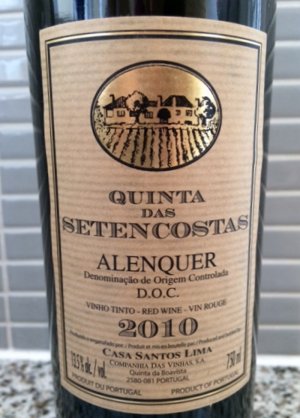Wine of the Month: Quinta das Setencostas
With a bustling farmer’s market and a vibrant food/restaurant scene here in West Hampstead, it seemed only fitting to launch a feature dedicated to wine, as not only is it fun to imbibe on its own, it truly sings with food.
In offering this new West Hampstead Life column, I hope to share my years of experience in wine retail, which includes tasting myriad wines in situ and learning from those who grow the grapes and oversee all aspects of wine production. I’ll be looking at what West Hampstead has to offer for wine drinkers, from wine shops to restaurants.
 For the first feature, I popped into Oddbins on West End Lane. Red wine was on the docket for a weekend meal and after searching through a nice selection of reds from all over the world (kudos to Oddbins for the diversity of its portfolio), I decided on a bottle of 2010 Quinta das Setencostas at £8.50.
For the first feature, I popped into Oddbins on West End Lane. Red wine was on the docket for a weekend meal and after searching through a nice selection of reds from all over the world (kudos to Oddbins for the diversity of its portfolio), I decided on a bottle of 2010 Quinta das Setencostas at £8.50.
This Portuguese wine is from Casa Santos Lima in the appellation of Alenquer, a valley near Lisbon. It is a red blend of four grape varietals: Castelão, Camarate, Tinta Miuda, and Preto-Martinho. The grapes are grown in clay and limestone soils, which benefit from the moderating influence of the Atlantic. The Setencostas is the result of a long maceration, traditional fermentation, and aging in oak barriques, with alcohol at 13.5 degrees.
In the glass, the Setencostas shows a dark, ruby color, with a nose of dark fruits, light spices, and vanilla. It has a mellow mouthfeel for a relatively weighty wine, showcasing dark and stone fruit (black cherries and plums), violets, and a hint of wild brambles, smoothed out by tannins that are very gentle. It took some time to distinguish which fruits I was tasting, perhaps due to the wine spending too much time in oak that was heavily toasted, a common practice that can hide some wine faults.
Happily, there appear to be no discernible faults in this wine: it possesses the correct acidity and weight, and the fruit is rather clean-tasting, meaning that the grapes were harvested at the right time. No amount of oak can hide the taste of fruit that has been harvested too late, which appears as taste of stewed fruit. In this case, I think the Setencoastas has simply spent too much time on oak in order to meet the taste requirements of all those wine drinkers who have become accustomed to the heavy oak of New World wines.
We had it with a stir-fry of beef and snap peas that had some Asian flavors – oyster sauce, sesame seed oil, and soy sauce, as well as julienned carrots and yellow peppers. We could have done with some hoisin, but didn’t have any! It would be highly disappointing to pair a tannic red wine with this Asian dish, but the Setencostas proved a worthy foil with its focus on forward fruit, rather than tannins. A such, the wine was smooth and enjoyable, highlighting the flavors of the dish rather than obfuscating them. That complementarity is the hallmark of a good food-wine pairing.
The Quinta das Setencostas is a veritable bargain, which makes it all the more attractive. Why not drop by Oddbins and try a bottle yourself?
If you’d like to recommend a wine shop or restaurant’s wine list for this WHL feature, please tweet me @kevinjruth.





Leave a Reply
Want to join the discussion?Feel free to contribute!